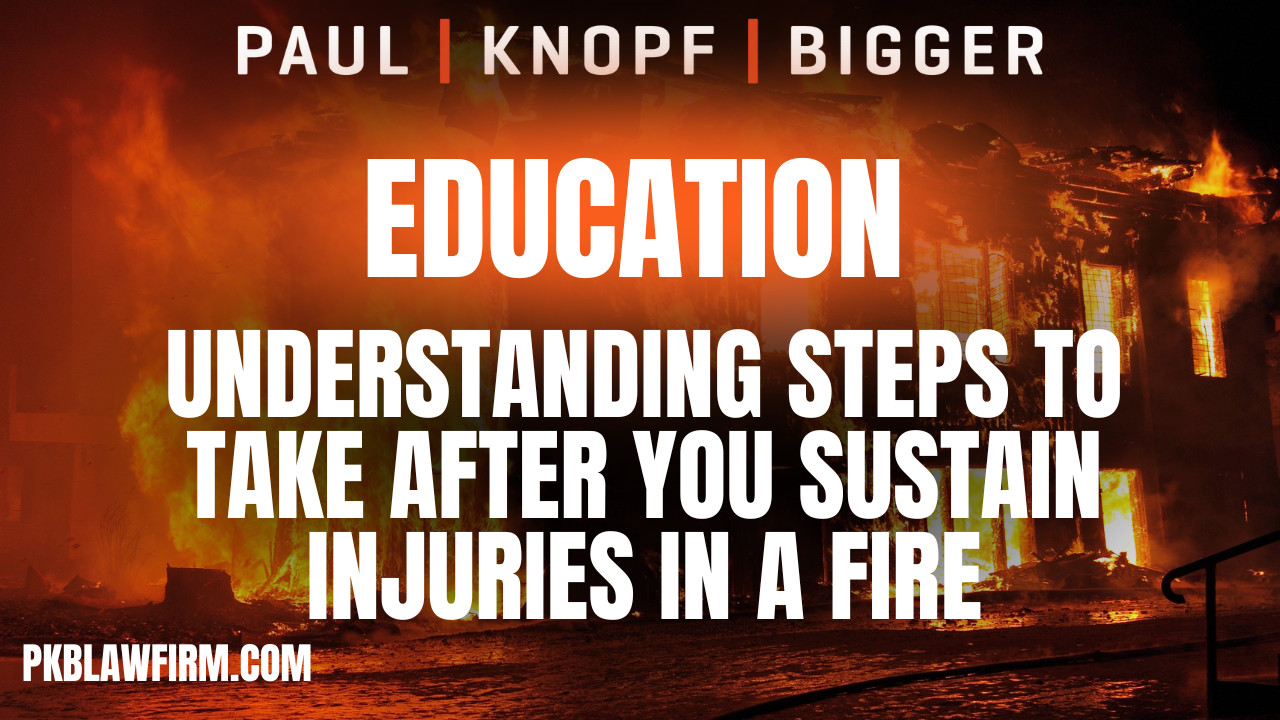
Orlando Fire Injury Lawyer | Legal Recourse & Injury Guide
Fire injuries are among the most excruciating and life-altering injuries one can endure. Victims deserve justice and compensation when these injuries result from someone else’s negligence. An Orlando fire injury lawyer at Paul | Knopf | Bigger aims to provide an understanding of the types of burn and smoke injuries, their causes, and the legal avenues available for victims in Orlando. Fire-related injuries are a serious issue in Florida, affecting hundreds of victims each year. Contact us now at (800) 434-4327.
Fire-Related Injuries
Types of Burn Injuries
Burn injuries are classified based on the severity of damage to the skin and underlying tissues. Understanding these classifications is crucial for identifying the appropriate medical and legal responses.
1st-Degree Burns
- Characteristics: Affect only the outermost layer of skin (epidermis).
- Symptoms: Redness, minor inflammation, and pain.
- Treatment: Typically heal within a week without the need for medical intervention.
2nd-Degree Burns
- Characteristics: Damage extends beyond the epidermis to the dermis (second layer of skin).
- Symptoms: Blisters, severe pain, swelling, and possible scarring.
- Treatment: Medical treatment may be required to prevent infection and manage pain.
3rd-Degree Burns
- Characteristics: Destroy the epidermis and dermis, reaching the fat layer beneath the skin.
- Symptoms: White, blackened, or charred skin; numbness due to nerve damage.
- Treatment: Often necessitates skin grafts and extensive medical care.
4th-Degree Burns
- Characteristics: Extend through all layers of the skin, affecting muscles, tendons, and bones.
- Symptoms: Life-threatening; significant risk of infection and other complications.
- Treatment: Requires immediate emergency medical attention and long-term rehabilitation.
Causes of Burn Injuries
Burn injuries can occur in various ways, often due to the negligence of others. Here are common scenarios leading to severe burns:
- Vehicle Accidents: Explosions or fires resulting from collisions involving cars, trucks, or motorcycles.
- Chemical Spills: Exposure to hazardous substances in workplaces or industrial sites.
- Electrical Failures: Faulty wiring or malfunctioning electrical appliances.
- Scalding Incidents: Hot water spills or defective water heaters.
- Radiation: Accidents during medical treatments or exposure to radiation sources.
- Explosions: Industrial accidents, gas leaks, or faulty products.
- Cooking Hazards: Kitchen accidents, including grease fires and stove malfunctions.
Consequences of Burn Injuries
Burn injuries can lead to severe physical, emotional, and financial challenges. Victims may face:
- Pain and Suffering: Persistent pain, emotional trauma, and diminished quality of life.
- Disfigurement: Permanent scarring and changes in appearance affecting self-esteem and social interactions.
- Medical Expenses: High costs associated with emergency care, surgeries, rehabilitation, and ongoing treatments.
- Lost Wages: Inability to work during recovery, potentially leading to long-term unemployment.
Understanding Smoke Inhalation Injuries
Smoke inhalation injuries occur when individuals breathe in harmful smoke particles and gases during a fire. These injuries can be as severe as burn injuries, often resulting in significant health complications.
The respiratory system is particularly vulnerable during a fire, as smoke can damage the airways and lungs and lead to systemic toxicity. Understanding the nature and impact of smoke inhalation injuries is essential for timely and effective medical intervention.
Types of Smoke Inhalation Injuries
Smoke inhalation injuries can be categorized based on the specific area of the respiratory system they affect and the type of toxic substances inhaled.
Thermal Injury
- Description: Caused by inhaling hot gases that can burn the respiratory tract.
- Symptoms: Swelling of the airway, hoarseness, difficulty breathing.
- Treatment: Immediate medical attention to secure the airway and prevent further damage.
Chemical Injury
- Description: Results from inhaling toxic chemicals found in smoke, such as carbon monoxide, cyanide, and ammonia.
- Symptoms: Headache, dizziness, confusion, nausea, and, in severe cases, loss of consciousness.
- Treatment: Administration of 100% oxygen, and antidotes for specific toxins (e.g., hydroxocobalamin for cyanide poisoning).
Particulate Injury
- Description: Involves inhalation of fine particulate matter that can penetrate deep into the lungs.
- Symptoms: Coughing, wheezing, respiratory distress, and long-term lung damage.
- Treatment: Bronchodilators, steroids, and respiratory support to manage symptoms and reduce inflammation.
Causes of Smoke Inhalation Injuries
Smoke inhalation injuries can result from various situations where individuals are exposed to smoke and toxic gases. Understanding these causes can help in prevention and risk management.
- Residential Fires: Fires in homes or apartment buildings often result in injuries caused by inhalation of smoke due to the enclosed space and high density of combustible materials.
- Common Sources: Electrical faults, cooking accidents, heating equipment malfunctions.
- Industrial Accidents: Fires in industrial settings can expose workers to various toxic chemicals and dense smoke.
- Common Sources: Chemical spills and reactions, explosions, and machinery malfunctions.
- Vehicle Fires: Fires resulting from vehicle accidents or mechanical failures can produce a mix of toxic fumes from burning fuel, plastics, and other materials.
- Common Sources: Car crashes, engine overheating, and electrical system failures.
- Wildfires: Large-scale wildfires produce vast amounts of smoke, affecting not only those in the immediate vicinity but also people living miles away.
- Common Sources: Natural causes (e.g., lightning strikes), human activities (e.g., unattended campfires, arson).
Legal Options for Fire Injury Victims in Orlando
Victims of fire injuries in Orlando have several legal avenues to seek compensation. Working with a skilled Orlando fire injury lawyer who can navigate these complex cases is crucial.
Premises Liability
Property owners are legally responsible for ensuring their premises are safe for visitors. If someone is injured on their property due to negligence, the owner may be held liable for damages.
Product Liability
Manufacturers and sellers can be held accountable for defective products that cause injury. Victims can file a product liability claim against responsible parties.
Workers’ Compensation
If a burn injury occurs at the workplace, workers can seek compensation through their employer’s workers’ compensation insurance.
Negligence Lawsuits
Negligence lawsuits allow victims to claim compensation for injuries caused by another party’s recklessness or carelessness.
Comparative Negligence in Fire Injury Cases
Under Florida’s comparative negligence rule, which applies in Orlando, a victim’s compensation is reduced based on their percentage of fault in the incident. For example, if a victim is found to be 20% responsible for their injuries, they can still recover 80% of the total damages. This system ensures that even if a victim shares some responsibility, they are not entirely barred from seeking compensation. However, the court will carefully evaluate each party’s actions to determine the extent of liability.
Recoverable Damages in an Orlando Fire Injury Case
Fire injury victims may seek compensation for:
- Economic Damages: Medical bills, lost wages, rehabilitation costs.
- Non-Economic Damages: Pain and suffering, emotional distress, loss of enjoyment of life.
- Punitive Damages: Awarded in cases of gross negligence.
The Role of an Orlando Fire Injury Lawyer at Paul | Knopf | Bigger
Navigating the legal aftermath of a severe burn injury requires expert guidance. An Orlando fire injury lawyer at Paul | Knopf | Bigger can:
- Evaluate Your Case: Determine the best legal strategy.
- Gather Evidence: Collect relevant documentation and witness statements.
- Negotiate Settlements: Secure fair compensation from opposing parties.
- Represent You in Court: Advocate for your rights if litigation becomes necessary.
Paul | Knopf | Bigger offers dedicated legal representation for fire injury victims. Contact us today for a free consultation at (800) 434-4327, or visit our Orlando / Winter Park and Tampa offices. Secure the justice and compensation you need to rebuild your life.
Sources:
- https://www.usfa.fema.gov/statistics/states/florida.html
- http://ww11.doh.state.fl.us/comm/_partners/infographics_injury_prevention/office_printing/fire_related_injuries_8.5×11.pdf
- https://www.myfloridacfo.com/division/sfm/ffirs
- https://myfwc.com/research/gis/wildlife/florida-fire/
- http://www.leg.state.fl.us/statutes/index.cfm?App_mode=Display_Statute&URL=0700-0799/0768/Sections/0768.81.html



